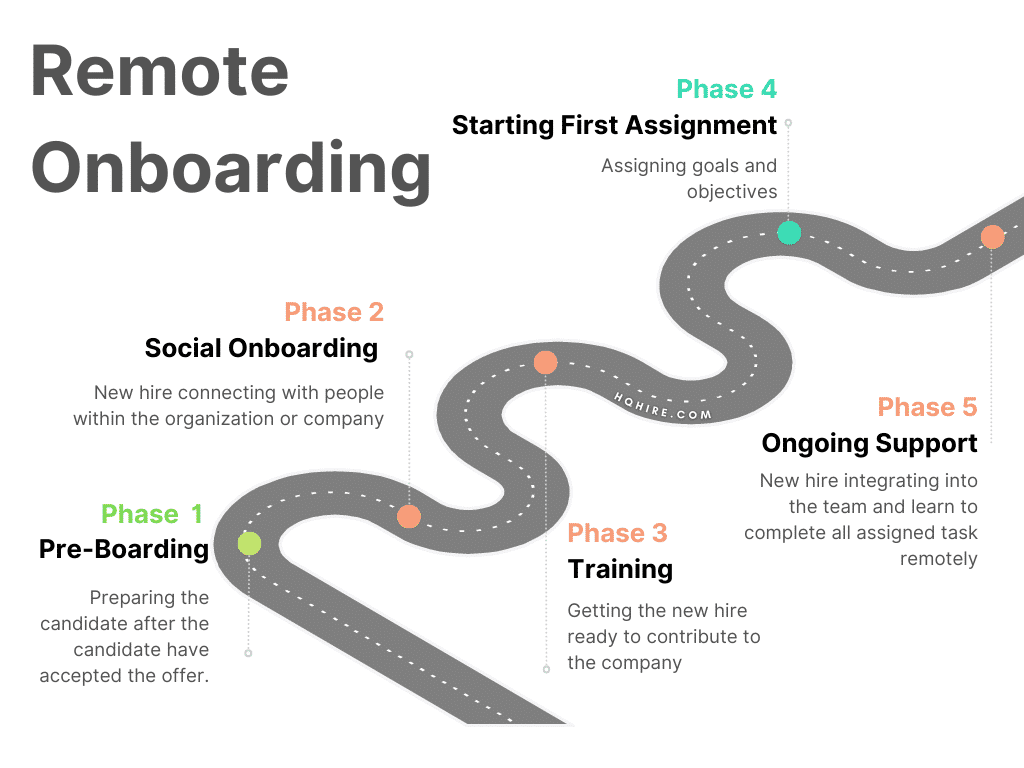Are you onboarding new employees who will be working remotely? Unlike traditional onboarding of new hires, the remote onboarding program for a remote team through video call, email and onboarding software is very different from in-person onboarding.
KEY TAKEAWAY
- Start early and begin onboarding before the employee’s start date to set a positive tone.
- Personalized welcome message and make new hires feel valued with personalized messages and virtual introductions.
- Ensure role clarity, define roles and expectations clearly to ensure success in a remote setting.
- Create a structured plan, have a detailed onboarding plan with milestones to guide the process.
- Training focus, always offer role-specific training and encourage continuous learning for professional growth.
Powerful New Remote Employee Onboarding Process Best Practices
As remote work and working from home is becoming more common, effective onboarding processes is key to help new employees feel welcomed.
Here we’ll look at the best practices for remote employee onboarding, whether you’re a seasoned HR professional or a new manager tasked with onboarding remote employees, getting some great idea on how to onboard your new hire is a great way to get started.

1. Start Early
Initiate the onboarding process well before the new remote employee’s first day.
- Provide a checklist for setting up a home office.
- Send a welcome email with a personalized touch.
Send them welcome materials, company swag, and clear instructions for setting up their remote work environment. This early engagement sets a positive tone and demonstrates your commitment to their success.
2. Personalized Welcome
Make your new remote employee feel valued with a personalized welcome message or video from the team or their manager.
Introduce them to immediate colleagues through virtual meetings, fostering a sense of belonging right from the start.
- Host a virtual welcome meeting with team members.
- Share fun facts about the new employee to spark conversations.
3. Clearly Define Roles and Expectations
Provide a detailed job description and outline their responsibilities. Setting clear performance expectations and goals is crucial for their success in a remote role.
- Share a comprehensive job description.
- Define key performance indicators (KPIs) for their role.
4. Structured Onboarding Plan
Develop a comprehensive onboarding plan that outlines timelines and milestones. Create a checklist of tasks and activities for the first weeks or months.
- Create a visual onboarding timeline.
- Include key dates and milestones.
This roadmap guides your new hire’s journey and ensures they don’t miss essential steps.
5. Training and Skill Development
Offer role-specific training sessions tailored to your remote employee’s needs. Encourage them to engage in skill development and continuous learning, fostering their professional growth.
- Provide access to online courses and resources.
- Schedule regular training sessions.
6. Buddy System
Assign an experienced employee as a mentor or buddy to your new remote employee.
- Establish a buddy program with clear roles and responsibilities.
- Encourage regular check-ins between the new hire and their buddy.
This mentor can answer questions, provide guidance, and facilitate social integration, helping the newcomer feel connected.
7. Virtual Team Building
Don’t underestimate the power of team building in a remote setting.
Organize virtual team-building activities or icebreakers to create opportunities for your new remote hires to bond with their colleagues in a relaxed, non-work setting.
- Schedule virtual game nights or trivia sessions.
- Create a virtual watercooler space for casual conversations.
8. Consistent Communication
Set up regular check-in meetings with managers and team members. Use collaboration tools for ongoing communication and updates. Transparency and accessibility are key to remote success.
- Use video conferencing for face-to-face meetings.
- Maintain a shared team calendar for scheduling.
9. Accessible Resources
Ensure your new remote employee has easy access to company policies, employee handbooks, and resources. Make sure they know where to find information, promoting self-sufficiency.
- Create a centralized online repository for resources.
- Provide easy-to-follow guides for accessing tools and systems.
10. Encourage Questions
Create an open and welcoming environment for questions and concerns. Establish a designated channel for asking questions and getting quick responses. Encourage curiosity and open dialogue.
- Designate a dedicated email address for questions.
- Encourage new hires to ask “why” and seek understanding.
11. Company Culture Integration
Share information about your company’s culture, values, and mission. Conduct virtual sessions to explain cultural norms and expectations. Instilling a sense of belonging in a remote environment is crucial.
- Host virtual “culture sessions” led by long-standing employees.
- Encourage discussions about how remote employees can contribute to the company culture.
12. Remote Tools Familiarization
Provide training on essential remote collaboration tools. Ensure your new remote employee is proficient in using video conferencing, chat apps, and project management tools. Technical proficiency enhances productivity.
- Offer tutorials and guides for each tool.
- Provide troubleshooting resources for common issues.
13. Individualized Development Plans
Create personalized development plans based on your new remote employee’s career goals. Identify opportunities for growth within your organization, fostering a sense of long-term commitment.
- Conduct career development discussions.
- Offer cross-training options to broaden skills.
14. Recognize Achievements
Acknowledge and celebrate milestones and achievements. Positive feedback and recognition for accomplishments motivate your new remote employee and boost morale.
- Establish a recognition program.
- Publicly celebrate work anniversaries and accomplishments.
15. Accessibility and Inclusivity
Ensure that remote onboarding materials are accessible to all employees, regardless of their abilities. Promote inclusivity and diversity within your organization, fostering a welcoming environment.
- Provide alternative formats for training materials.
- Emphasize the importance of inclusivity in company culture.
16. Compliance and Security Training
Conduct training on data security, compliance, and confidentiality. Ensure your new remote hire is aware of cybersecurity best practices, safeguarding your organization.
- Share real-world security scenarios.
- Promote a culture of data protection and ethical conduct.
17. Performance Evaluation
Schedule regular performance evaluations and feedback sessions. Provide opportunities for your new remote employee to discuss their progress and challenges, promoting growth.
- Conduct 360-degree feedback sessions.
- Set clear expectations for performance reviews.
18. Continuous Support
Offer ongoing support and resources beyond the initial onboarding period. Encourage your new remote employee to reach out for assistance when needed. A supportive environment fosters long-term success.
- Maintain open lines of communication.
- Provide access to HR and support channels.
19. Adaptability and Flexibility
Emphasize adaptability and the ability to work in a dynamic remote environment. Provide guidance on managing remote work challenges, equipping your new remote hire for any situation.
- Share best practices for time management.
- Offer stress management resources.
20. Employee Well-being
Promote employee well-being initiatives and resources. Encourage a healthy work-life balance and stress management. A well-balanced remote employee is a more productive one.
- Organize virtual wellness sessions.
- Provide resources for mental health support.
Why Follow the Best Practices for Onboarding Remote Employees?
Embracing best practices in onboarding remote employees is essential for a positive start and long-term success. This is especially true for remote onboarding your remote workers into their new job.
- A well-structured onboarding process fosters engagement, satisfaction, and retention.
- Well planned remote onboarding also streamlines operations, enabling swift integration and enhancing overall team productivity.
Prioritizing these practices signals a commitment to employee development, contributing to a supportive culture and long-lasting success.
Good onboarding best practices can benefit both the employer and employee.
Benefits of Efficient Onboarding Process For Employers
1. Efficiency and Productivity
Embracing best practices for remote onboarding streamlines the process, reducing the time it takes for new remote employees to become productive. This efficiency translates into tangible gains for the organization, as the workforce can contribute effectively from day one.
2. Cost Savings
A well-structured onboarding process minimizes the need for costly rehiring due to high turnover rates. By retaining employees through effective onboarding, employers can save on recruitment and training expenses.
3. Cultural Alignment
Company culture plays a pivotal role in organizational success. Following best practices ensures that remote employees not only understand but also align with the company’s culture, values, and mission. This alignment fosters a cohesive and motivated workforce.
4. Legal Compliance
Compliance with legal standards and data security is crucial. Best practices include training on data security, compliance, and confidentiality, helping organizations avoid legal pitfalls and safeguard sensitive information.
5. Adaptability and Innovation
The ability to adapt to changing circumstances is a competitive advantage. Best practices equip remote employees with the skills to thrive in dynamic remote work environments, fostering innovation and resilience.
6. Employee Well-being
Prioritizing employee well-being, a core aspect of best practices, leads to higher job satisfaction and engagement. Satisfied employees are more likely to contribute positively to the organization’s success.
Benefit of Great Onboarding Experience For Employees
1. Smooth Transition
Starting a new remote job can be daunting. Following best practices ensures a structured and guided introduction to the new role and work environment, making the transition smoother and less stressful.
2. Clarity and Expectations
Uncertainty can hinder performance. Best practices provide clear job descriptions and performance expectations, empowering remote employees to understand their responsibilities and excel in their roles.
3. Professional Growth
Remote work shouldn’t hinder professional development. Best practices encourage role-specific training and continuous learning, fostering career growth opportunities for remote employees.
4. Support and Connection
Feeling isolated is a common challenge in remote work. Best practices address this by assigning mentors or buddies and organizing team-building activities, helping remote employees feel connected and supported.
5. Recognition and Motivation
Recognizing achievements and celebrating milestones, as advocated by best practices, motivates remote employees and boosts morale. This positive reinforcement encourages them to excel in their roles.
6. Inclusivity and Accessibility
Accessibility is a fundamental aspect of remote work. Best practices ensure that onboarding materials are accessible to all employees, fostering inclusivity and diversity.
Adopting New Employee Remote Onboarding Best Practices
Onboard new employees is a delicate process where you want to make them feel comfortable in a new remote working environment.
By following these best practices, you’ll pave the way for your new remote employees to thrive in their roles, contribute to your organization’s success, and ultimately, become loyal and engaged team members.
Virtual onboarding isn’t just about getting paperwork done; it’s about creating a positive remote onboarding experience that makes your employees feel welcome, supported, and equipped for success.
However, onboarding new remote team have a lot of moving parts, and creating your own onboarding checklist can help guide you throughout the journey of onboarding new employees remotely.
Let’s take a look at how you can create your own “Remote Onboarding Checklist” next.






